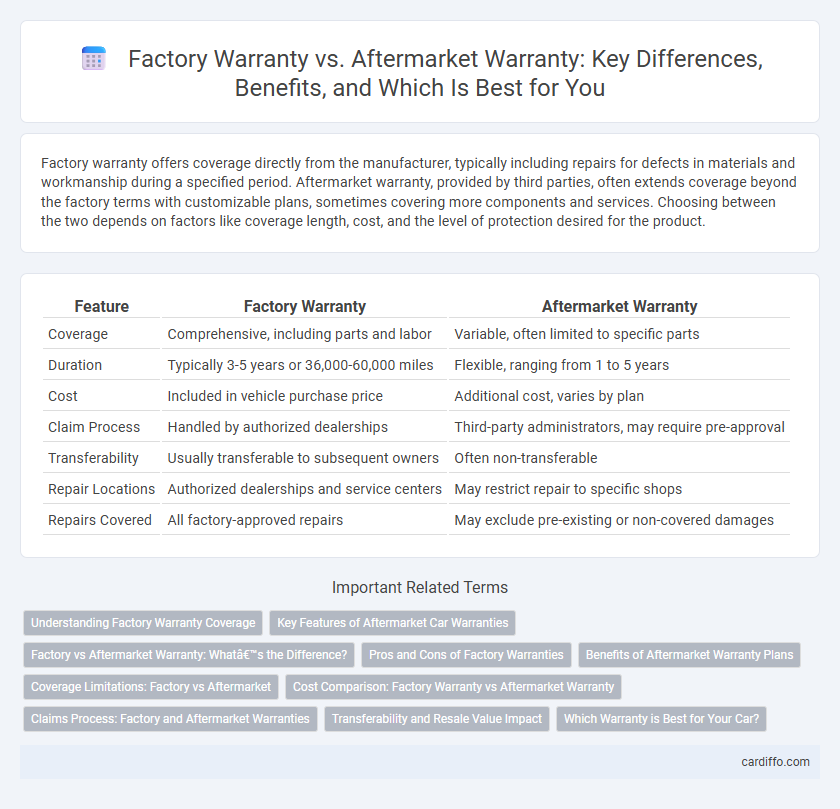Factory warranty offers coverage directly from the manufacturer, typically including repairs for defects in materials and workmanship during a specified period. Aftermarket warranty, provided by third parties, often extends coverage beyond the factory terms with customizable plans, sometimes covering more components and services. Choosing between the two depends on factors like coverage length, cost, and the level of protection desired for the product.
Table of Comparison
| Feature | Factory Warranty | Aftermarket Warranty |
|---|---|---|
| Coverage | Comprehensive, including parts and labor | Variable, often limited to specific parts |
| Duration | Typically 3-5 years or 36,000-60,000 miles | Flexible, ranging from 1 to 5 years |
| Cost | Included in vehicle purchase price | Additional cost, varies by plan |
| Claim Process | Handled by authorized dealerships | Third-party administrators, may require pre-approval |
| Transferability | Usually transferable to subsequent owners | Often non-transferable |
| Repair Locations | Authorized dealerships and service centers | May restrict repair to specific shops |
| Repairs Covered | All factory-approved repairs | May exclude pre-existing or non-covered damages |
Understanding Factory Warranty Coverage
Factory warranty coverage typically includes repairs and replacements for defects in materials or workmanship during a specified period, usually ranging from three to five years or a specific mileage limit such as 36,000 miles. This coverage often extends to essential components like the engine, transmission, and electrical systems, ensuring the vehicle performs as intended by the manufacturer. Understanding the exact terms and limitations of factory warranty coverage is crucial for vehicle owners to avoid unexpected repair costs and maintain the vehicle's resale value.
Key Features of Aftermarket Car Warranties
Aftermarket car warranties offer extended coverage beyond the factory warranty, often including services such as roadside assistance, rental car reimbursement, and coverage for high-mileage vehicles. These plans typically provide flexible terms, customizable coverage options, and availability for vehicles no longer supported by the manufacturer. Unlike factory warranties limited to the original owner and specific time frames, aftermarket warranties can be transferred to new owners, enhancing resale value.
Factory vs Aftermarket Warranty: What’s the Difference?
Factory warranty provides coverage directly from the manufacturer, typically including comprehensive protection for parts and labor within a specific time or mileage limit, ensuring authenticity and authorized service. Aftermarket warranty is offered by third-party providers, often extending coverage beyond the factory warranty period with customizable plans but may include restrictions on service providers and potential variations in claim processes. Understanding the key distinctions in coverage scope, cost, and service requirements helps consumers make informed decisions between factory and aftermarket warranty options.
Pros and Cons of Factory Warranties
Factory warranties provide comprehensive coverage directly from the manufacturer, ensuring repairs use genuine parts and maintain vehicle integrity. They typically offer longer coverage periods with minimal out-of-pocket costs, but may require servicing at authorized dealerships, potentially limiting convenience and flexibility. However, factory warranties often exclude wear-and-tear items and can be voided by unauthorized repairs or modification, posing risks for users seeking customization.
Benefits of Aftermarket Warranty Plans
Aftermarket warranty plans offer extended coverage beyond the standard factory warranty, providing owners with protection against unexpected repair costs for a longer period. These plans often include flexible terms, customizable coverage options, and the ability to use a wide network of authorized repair shops. Customers gain peace of mind and can potentially save significant expenses on parts and labor that are no longer covered by the original factory warranty.
Coverage Limitations: Factory vs Aftermarket
Factory warranties typically offer comprehensive coverage including powertrain, bumper-to-bumper, and corrosion protection, ensuring repairs are made with OEM parts by certified technicians within a specified period or mileage. Aftermarket warranties often have more limited coverage, excluding certain components like emissions systems or electronics, and may involve independent repair shops with varied parts quality standards. Consumers should carefully review coverage limitations and claim conditions, as aftermarket warranties might impose stricter maintenance requirements and deductibles compared to factory options.
Cost Comparison: Factory Warranty vs Aftermarket Warranty
Factory warranties typically come at no additional cost as they are included with the purchase of a new product, offering comprehensive coverage backed by the manufacturer. Aftermarket warranties often require separate purchase and can vary significantly in price depending on coverage levels, with some plans being more cost-effective for extended protection beyond the factory period. Evaluating the cost comparison involves considering the initial price versus potential repair expenses, as aftermarket warranties may provide savings for long-term ownership despite upfront costs.
Claims Process: Factory and Aftermarket Warranties
Factory warranty claims typically require servicing at authorized dealerships, ensuring genuine parts and manufacturer-trained technicians handle repairs, which streamlines approval and coverage verification. Aftermarket warranty claims often involve multiple service providers and may require additional documentation to validate repairs, potentially extending the claims processing time. Understanding these differences helps consumers anticipate service requirements and avoid claim denials based on warranty terms or provider limitations.
Transferability and Resale Value Impact
Factory warranties typically offer transferability to subsequent owners, enhancing the vehicle's resale value by providing added assurance of coverage. Aftermarket warranties often lack this transferability, which can reduce buyer confidence and negatively impact resale value. Vehicles with factory warranties generally maintain higher market appeal due to the perceived reliability and ease of claim processing.
Which Warranty is Best for Your Car?
Factory warranty offers comprehensive coverage directly from the vehicle manufacturer, ensuring genuine parts and authorized service centers, which often preserves resale value and provides peace of mind. Aftermarket warranty plans can be more flexible and affordable, covering specific parts or repairs beyond the original warranty period but may vary significantly in terms of coverage and service quality. Choosing the best warranty depends on factors such as vehicle age, mileage, driving habits, and repair budget, with factory warranties typically best for newer cars and aftermarket plans suited for older or high-mileage vehicles.
Factory Warranty vs Aftermarket Warranty Infographic

 cardiffo.com
cardiffo.com